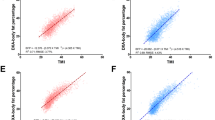Abstract
The primary objective of this study was to determine gender differences in total body fat mass (TBFM) and body fat distribution (subcutaneous fat mass, SFM; and internal fat mass, IFM) in a cross-sectional sample of 280 children. Measurements of the body composition of 141 boys and 139 girls, all apparently healthy and aged 3–6 years were made using bioelectrical impedance. Determinations of impedance were made using a four-terminal impedance analyzer (TP-95K; Toyo Physical, Fukuoka, Japan). Lean body mass (LBM) was calculated using a previously published equation [Goran MI, Kaskoun MC, Carpenter WH, Poehlman ET, Ravussin E, Fontvieikke A-M (1993) Estimating body composition of young children by using bioelectrical resistance. J Appl Physiol 75: 1776–1780]. SFM was calculated using a modification of the equation derived by Skerjl [Skerjl B, Brozek J, Hunt EE (1953) Subcutaneous fat and age changes in body build and body form in women. Am J Phys Anthrop 11: 577–580] and Davies [Davies PSW, Jones PRM, Norgan NG (1986) The distribution of subcutaneous and internal fat in man. Ann Hum Biol 13: 189–192]. The main modifications of the equation in the present study were the introduction of: (1) mean thickness of adipose tissue over body surface/2, and (2) skin mass. IFM was calculated as the difference between TBFM and SFM. The body mass index (BMI; kg/m2) was calculated from the formula: body mass/height2. For each gender, the subjects in the lowest and highest 25th percentiles were designated as “low body mass” and “high body mass”, respectively. In the present study, no gender differences in absolute TBFM, SFM and IFM were observed in either of these groups. In contrast, gender differences in relative TBFM (%Fat) and SFM (SFM/mass) were evident in girls. However, the four subgroups were similar in terms of relative IFM (IFM/mass). The TBFM was independently related to SFM, IFM and %Fat in both genders after adjustment for BMI; however, there was no significant association of SFM with IFM after adjustment for BMI in any group. Even after adjustment for BMI, IFM was independently related to %Fat in both genders, although SFM was not independently related to %Fat in any group except low-body-mass boys. This study shows that relative TBFM and SFM are higher in high-body-mass groups and tend to be higher in girls than in boys, and that the higher %Fat in high-body-mass girls than in high-body-mass boys appears to be associated with internal adipose tissue deposits. External adipose tissue mass does not appear to be related to the higher %Fat levels in high-body-mass girls. In addition, subcutaneous fat mass appears to be higher in low-body-mass girls than in low-body-mass boys, although this observation needs confirmation using more valid measures of subcutaneous fat such as computerized tomography and magnetic resonance imaging.
Similar content being viewed by others
Author information
Authors and Affiliations
Additional information
Accepted: 18 February 2000
Rights and permissions
About this article
Cite this article
Komiya, S., Eto, C., Otoki, K. et al. Gender differences in body fat of low- and high-body-mass children: relationship with body mass index. Eur J Appl Physiol 82, 16–23 (2000). https://doi.org/10.1007/s004210050646
Issue Date:
DOI: https://doi.org/10.1007/s004210050646




